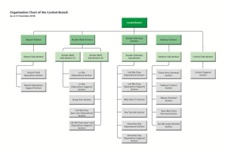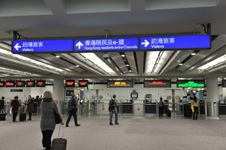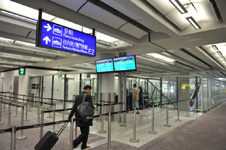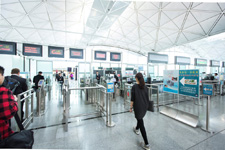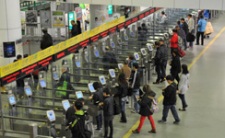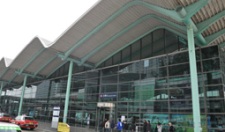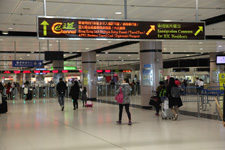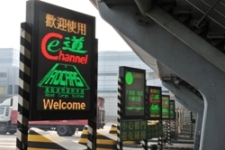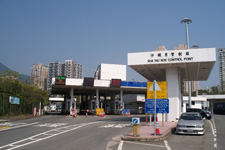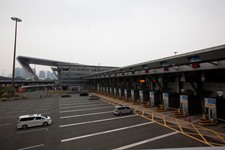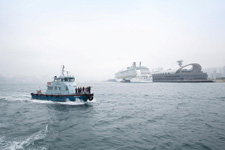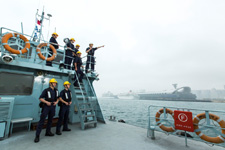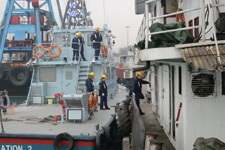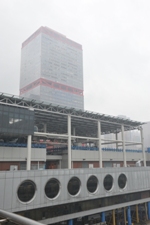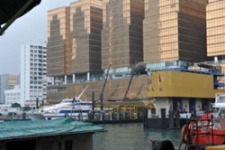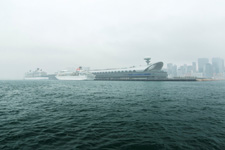Control Branch
Under the command of an Assistant Director, the Control Branch comprises the Airport Division, the Border (Rail) Division, the Border (Vehicles) Division and the Harbour Division. The Airport Division and the Border (Rail) Division are each headed by a Senior Principal Immigration Officer while the Border (Vehicles) Division and the Harbour Division are each headed by a Principal Immigration Officer. The divisions share responsibilities in maintaining immigration control by denying entry of undesirable persons and preventing wanted criminals from departure, and facilitating the mobility of travellers.
Immigration Control Points
Unlike some parts of the world, the Immigration Department in Hong Kong examines every person passing in and out of Hong Kong, be it by air, land or sea. An effective immigration control is important towards maintaining law and order as well as the harmonious relationship with different nations and regions. Through immigration examination, wanted criminals are intercepted while undesirables are denied entry into Hong Kong. Persons who do not have the right of abode or the right to land in Hong Kong must fulfill normal immigration requirements when seeking to enter Hong Kong. These include the possession of valid travel documents, sufficient means of support and re-entry facilities to their countries of domicile. Passengers who cannot fulfill these requirements or whose bona fides as genuine visitors are in doubt will not be allowed to enter Hong Kong and will be repatriated. In 2014, 42,177 passengers were refused permission to land in Hong Kong.
The Department is committed to providing efficient and courteous services at control points and efforts are constantly made to facilitate travellers. This enables the tourists to have a pleasant and welcoming first impression as soon as they arrive in Hong Kong and have a good memory of Hong Kong as a warm and nice place.
Airport Division
The Airport Division is responsible for exercising immigration control at the Hong Kong International Airport (HKIA).
Passenger Traffic
The HKIA is one of the busiest airports in the world. In 2014, 43.2 million landing and departing passengers used the HKIA.
With effect from January 2010, the Airport Division has enhanced its performance pledge. The new pledge is to clear 98 per cent of residents and 95 per cent of visitors within 15-minute waiting time. In 2014, 100 per cent of residents and 99.9 per cent of visitors were cleared within 15-minute waiting time in the Airport.
Spot Checks
To prevent the entry of undesirable persons and deter illegal migration activities, the Airport Division from time to time conducts spot checks on passengers in the arrival and departure halls, transit lounge, transfer areas and boarding gates. In 2014, 174 persons were intercepted for investigation in the Airport for activities related to fraudulent passports and visas.
Customer Service
To provide facilitation to the travelling public, ‘Single Service Points’ were established at all immigration halls in the HKIA in November 2006. Each of the Single Service Points serves the functions of ‘Courtesy Channel’ for holders of diplomatic passports and passengers requiring assistance, and as ‘Frequent Visitor Channel’ for frequent travellers who have visited Hong Kong via the HKIA three times or more in the preceding 12 months, and who have been issued with a Frequent Visitor Card by the Airport Authority Hong Kong.
Business Aviation Centre
To meet the demand for business aviation service, the Business Aviation Centre was set up to provide travel convenience to users of private or chartered aircrafts. Business travellers benefit most from the dedicated immigration clearance services provided on a user-pay basis. In 2014, a total of 9,157 aircrafts and 63,045 travellers and crew used the centre.
The SkyPier
The SkyPier, a cross-boundary passenger ferry terminal for transit passengers located at the HKIA, provides direct air-sea link between the HKIA and eight ports in the Pearl River Delta, namely Nansha of Guangzhou, Shekou and Fuyong of Shenzhen, Humen of Dongguan, Zhongshan, Jiuzhou of Zhuhai, Macao Maritime Ferry Terminal and Taipa. Transit passengers using the SkyPier services enjoy travel convenience at the HKIA without having to go through immigration and customs formalities. There are 84 participating airlines that provide check-in services at the SkyPier. In 2014, more than 1.92 million arriving and 0.83 million departing transit passengers made use of the SkyPier.
To further enhance the service, cross-boundary one-stop check-in services are available at Shekou, Fuyong, Humen, Zhongshan, Macao Maritime Ferry Terminal and Taipa. Passengers can obtain their boarding passes and check in their luggage for direct transfer from ferries using the SkyPier to their designated flights at the HKIA. Currently, there are 16 airlines participated in providing the service.
Frequent Visitor e-Channel
From 19 May 2008 onwards, visitors aged 18 or above who hold a valid HKSAR Travel Pass, APEC Business Travel Card with the economy code ‘HKG’ or HKIA Frequent Visitor Card and who have successfully enrolled with the Immigration Department of HKSAR, are able to enjoy self-service immigration clearance at the HKIA. From 7 September 2009, the frequent visitor e-Channel service has been extended to selected members of Frequent Flyer Programmes of designated airlines which have joined this arrangement. From 30 April 2012, the service has been further extended to include visitors (a) holding a valid travel document which does not require an entry visa / permit for entering Hong Kong; (b) having made visits to Hong Kong by air via the HKIA for not less than three times in the 12 months immediately before enrolment; and (c) having no adverse record in Hong Kong.
Following the mutual use of automated clearance service arrangement with the Republic of Korea in December 2013, similar arrangements with the Republic of Singapore and the Federal Republic of Germany were implemented in September and November 2014 respectively. All eligible visitors under the new agreements may enrol for e-Channel service at the Airport or Macau Ferry Terminal Control Point.
As at 31 December 2014, 190,774 frequent visitors have enrolled for the service. 1,987,955 arriving and 1,883,424 departing visitors have made use of the self-service immigration clearance.
At present, a total of 16 frequent visitor e-Channels are installed at HKIA, with 12 at the arrival halls and 4 at the departure halls.
Border (Rail) Division
The Border (Rail) Division comprises three control points located at Lo Wu, Hung Hom and Lok Ma Chau Spur Line. The Lo Wu and Lok Ma Chau Spur Line Control Points handle passengers conveyed by the MTR. The Hung Hom Control Point provides immigration clearance service for passengers who take through-trains running between the Mainland and Hong Kong.
Lo Wu Control Point
Being the busiest control point in Hong Kong with the highest passenger traffic, the Lo Wu Control Point handled over 87.1 million passengers in 2014. The passenger traffic decreased by 5.4 per cent as compared with that of 2013. Among them, 25.7 million were visitors, representing a slight decrease of 0.5 per cent as compared with that of 2013.
The traffic at the Lo Wu Control Point was extremely busy on festive days. In 2014, the daily average passenger traffic was around 240,000. During weekends or festive periods, the daily passenger figure could exceed 270,000. To cope with the huge passenger traffic during festive periods, the Department arranged extra manpower from other sections to reinforce the Lo Wu Control Point. In 2014, 99.8 per cent of passengers were cleared within 30 minutes.
To expedite the clearance of cross-boundary students (CBS), 6 designated e-Channels for CBS have been put into operation at the Lo Wu Control Point. A total of 25 frequent visitor e-Channels are installed, with 14 at the arrival hall and 11 at the departure hall.
Hung Hom Control Point
The Hung Hom Control Point provides clearance services for travellers taking through-trains to and from the Mainland. The daily 26 runs of through-trains to and from the Mainland serve Dongguan, Guangzhou, Foshan and Zhaoqing of Guangdong province, and as far as Shanghai and Beijing. Passenger traffic in 2014 reached 4.48 million, representing an increase of 0.6 per cent over the previous year. In 2014, 99.8 per cent of passengers were cleared within 30 minutes.
Lok Ma Chau Spur Line Control Point
The Lok Ma Chau Spur Line Control Point is located at Lok Ma Chau Terminus (the Terminus) of the MTR East Rail Line and is another land boundary control point for railway passengers. There is a Public Transport Interchange adjacent to the Terminus to cater for cross-boundary passengers using franchised buses, public light buses and taxis. The control point is linked to the Futian Port of Shenzhen by a two-level passenger bridge.
The passenger traffic at the Lok Ma Chau Spur Line Control Point has continued to increase since its commissioning. In 2014, over 54.6 million passengers travelled through this control point. The daily average number of passengers in 2014 was149,796, while the average number of passengers in 2013 was 127,862, indicating a sharp increase of 17.2 per cent. In 2014, 99.5 per cent of passengers were cleared within 30 minutes.
A total of 22 frequent visitor e-Channels are installed, with 13 at the arrival hall and 9 at the departure hall.
Border (Vehicles) Division
The Border (Vehicles) Division comprises four control points located at Lok Ma Chau, Man Kam To, Sha Tau Kok and Shenzhen Bay. These control points provide immigration clearance services for vehicular traffic and passengers travelling to and from the Mainland by shuttle buses (at Lok Ma Chau only), coaches or private cars.
Lok Ma Chau Control Point
With its commissioning on 1 July 2007, the Shenzhen Bay Control Point has diverted some of the cross-boundary traffic of the Lok Ma Chau Control Point. In 2014, the vehicle throughput at the Lok Ma Chau Control Point was 9.03 million. Amongst these vehicles, private cars accounted for 3.44 million, representing a slight decrease of 0.3 per cent when compared with that in 2013. In 2014, 28.5 million passengers travelled through the Lok Ma Chau Control Point, including 10.31 million visitors who represented 36 per cent of the passenger mix. In 2014, 99.8 per cent of passengers were cleared within 30 minutes.
24-hour Boundary Crossing for Passengers at Lok Ma Chau Control Point
The Lok Ma Chau Control Point has been providing round-the-clock passenger clearance service since 27 January 2003. In 2014, a daily average of 11,600 passengers travelled through the control point during the overnight period (midnight to 6:30 a.m.). The overnight passenger traffic rose beyond 12,400 during weekends or public holidays.
Improvement works at Lok Ma Chau Passenger Clearance Building commenced in November 2011 and the whole project is targeted for completion by early 2015. Upon completion of the project, the number of e-Channels will be increased from the original 20 to 33, while the facilities of the relevant departments will also be enhanced. In addition, the construction of two additional kiosks for private cars is scheduled to be completed in mid-2015. By then, the number of kiosks for private cars will be increased from 14 to 16.
Man Kam To Control Point
The improvement works for the passenger terminal of Man Kam To Control Point was completed in August 2013 and the control point had re-commissioned in full service since 26 August 2013, providing immigration clearance services to cross-boundary vehicles and passengers. The number of e-Channels increased from the original 9 to 16, including 7 frequent visitor e-Channels with 4 at the arrival hall and 3 at the departure hall. In 2014, the vehicle throughput at the Man Kam To Control Point was 1.74 million, representing an increase of 9.1 per cent when compared with that of 2013. In addition, 3.69 million passengers travelled through this control point, including 2.18 million visitors who represented 59 per cent of the passenger mix. In 2014, 100 per cent passengers were cleared within 30 minutes.
Sha Tau Kok Control Point
The Sha Tau Kok Control Point provides immigration clearance services to cross-boundary vehicles and passengers. Passengers mainly travel by coaches, hire cars or private cars running between the Mainland and Hong Kong. In 2014, the vehicle throughput at the Sha Tau Kok Control Point was 0.8 million, representing a decrease of 17.1 per cent when compared with that of 2013. 3.22 million passengers travelled through the Sha Tau Kok Control Point, representing a decrease of 5.3 per cent over 2013. In 2014, 100 per cent of passengers were cleared within 30 minutes.
Starting from 1 July 2009, the daily operating hours of Sha Tau Kok Control Point were extended by two hours in the evening. The new operating hours are from 7:00 a.m. to 10:00 p.m. The new arrangement makes border-crossing more convenient for passengers and freight operators.
Shenzhen Bay Control Point
The Shenzhen Bay Control Point is the first land boundary control point providing ‘Co-location of Boundary Crossing Facilities’ to both passenger and vehicular traffic between the Mainland and Hong Kong.
With the co-location arrangement, much time is saved as passengers conveyed by coaches will only have to get on and off the vehicles once instead of twice when going through immigration clearance at both immigration authorities within the Passenger Terminal Building. For each vehicular clearance kiosk, staff of both Immigration Department and Customs and Excise Department is housed in two closely adjoining compartments, facilitating the provision of one-stop immigration and customs clearance services to cross-boundary vehicles.
The control point operates from 6:30 a.m. to midnight. At present, there are various cross-boundary coaches providing transportation services between Hong Kong and the Mainland. The Public Transport Interchange in the Hong Kong Port Area also provides transportation services of urban / New Territories taxi, franchised bus and public light bus.
The passenger crossings at the Shenzhen Bay Control Point increased by 14.8 per cent from 32.4 million in 2013 to 37.2 million in 2014, including 20 million visitors who made up 54 per cent of the passenger mix.
The vehicular traffic was 3.64 million in 2014, representing a slight decrease of 0.8 per cent when compared with 3.67 million in 2013. Among these vehicles, 70.5 per cent were private cars, 19.3 per cent were goods vehicles and the rest were coaches.
Traffic statistics showed that the Shenzhen Bay Control Point is becoming popular among cross-boundary passengers and plays a vital role in relieving the burden of other border control points. In 2014, 98.9 per cent of passengers were cleared within 30 minutes.
A total of 17 frequent visitor e-Channels are installed, with 9 at the arrival hall and 8 at the departure hall.
Starting from 2014, the designated Hong Kong resident kiosks for southbound private cars with ‘Driver On-board Only’ and ‘One Passenger On-board Only’ are put into operation from 3:00 p.m. to 9:00 p.m. daily at the Shenzhen Bay Control Point.
Simplified Clearance Procedure and On-board Clearance Service for Cross-boundary Students
To further assist cross-boundary students (CBS) to travel between the Mainland and Hong Kong, the Department had implemented the simplified clearance procedure for CBS in the 2012-13 school year at the Lok Ma Chau Spur Line, Shenzhen Bay, Lok Ma Chau, Man Kam To and Sha Tau Kok Control Points and extended it to Lo Wu Control Point in the 2013-14 school year. The procedure made use of information technology and portable device to enhance the immigration clearance process for CBS. In addition, the on-board clearance service had also been extended from Man Kam To and Sha Tau Kok Control Points to Lok Ma Chau Control Point to provide CBS with speedy and safe clearance. In the 2014-15 school year, 170 cross-boundary school buses travelled between Hong Kong and Shenzhen via the 4 vehicular control points on every school day, representing an increase of 21 per cent when compared with 140 cross-boundary school buses in the 2013-14 school year.
Harbour Division
The Harbour Division is responsible for providing immigration services to people travelling through the ports of Hong Kong. There are five sections under the command of the Harbour Division, namely the Harbour Control Section, the Macau Terminal Section, the China Ferry Terminal Section, the Tuen Mun Ferry Terminal Section and the Kai Tak Cruise Terminal Section.
Harbour Control Section
One of the duties of the Harbour Control Section is to conduct immigration clearance on incoming and outgoing vessels at the two designated immigration anchorages, namely the Eastern Quarantine and Immigration Anchorage and the Western Quarantine and Immigration Anchorage. In 2014, the Harbour Control Section cleared a total of 183,440 vessels, representing an increase of 6.8 per cent over the year of 2013.
Besides, the Harbour Control Section is responsible for handling cases concerning repatriation and emergency discharge of seamen, deserters, stowaways, etc. To step up post-entry enforcement measures, the Ship Searching Unit of the section conducts searches and spot checks on vessels in Hong Kong waters regularly to ensure that all incoming vessels comply with the immigration requirements.
The Ship Searching Unit comprises four operation teams and one intelligence and logistics support team. The operation teams are responsible for conducting searches and spot checks on vessels in Hong Kong waters to detect evasion of immigration examination cases, forgeries, illegal immigrants, overstayers, etc. Ad hoc operations and searches are conducted by the unit to strengthen immigration control at sea and combat illicit immigration activities. The intelligence and logistics support team is responsible for the collection and analysis of relevant information and intelligence.
Pre-arrival Clearance Scheme
To facilitate the cargo and logistics industry, the Pre-arrival Clearance Scheme has been launched for years. Approved vessels can proceed directly to berths or terminals for cargo operations without having to wait for immigration clearance at the anchorages. In 2014, 24,786 ocean-going vessels and 57,385 Mainland river or coastal trade vessels were approved under this Scheme prior to their entry to Hong Kong.
The arrangement helps save much of the operational costs and time. It also helps develop and promote Hong Kong’s position as a preferred international and regional transportation and logistics hub.
Macau Terminal Section
In 2014, a total of 17.7 million passengers travelled to and from Macao and some nearby ports of Guangdong Province via the Macau Ferry Terminal. The figure slightly increased by 0.1 per cent as compared to that in 2013. The terminal was the busiest immigration check point among all harbour control points. The majority of the passengers were Hong Kong residents, accounting for 59 per cent of the passenger traffic which was 10.4 million. The visitor traffic was 7.31 million, increased by 5.6% per cent as compared to that in 2013. The terminal operates round-the-clock with about 300 daily sailings between Hong Kong and Macao or the Mainland. There is also helicopter service between Hong Kong and Macao with about 38 flights per day.
Following the mutual use of automated clearance service arrangement with the Republic of Korea in December 2013, similar arrangements with the Republic of Singapore and the Federal Republic of Germany were implemented in September and November 2014 respectively. All eligible visitors under the new agreements may enrol for e-Channel service at the Airport or Macau Ferry Terminal Control Point. A total of 10 frequent visitor e-Channels are installed, with 6 at the arrival hall and 4 at the departure hall.
China Ferry Terminal Section
The China Ferry Terminal Section provides immigration clearance to passengers travelling by vessels between Hong Kong and the Mainland or Macao at the China Ferry Terminal.
In 2014, the China Ferry Terminal handled a daily average of 125 sailings between Hong Kong and Macao or the Mainland. In the same year, 9.2 million passengers were processed by the China Ferry Terminal Section. The majority of the passengers were visitors, accounting for 57.2 per cent of the passenger traffic.
A total of 6 frequent visitor e-Channels are installed, with 4 at the arrival and 2 at the departure hall.
Tuen Mun Ferry Terminal Section
The Tuen Mun Ferry Terminal Section handled immigration clearance for passengers at the Tuen Mun Ferry Terminal through its Tuen Mun Ferry Terminal Sub-section until suspension of the ferry service in July 2012. Its River Trade Terminal Sub-section provides immigration clearance to Mainland river or coastal trade vessels.
The River Trade Terminal Sub-section provides round-the-clock immigration clearance to Mainland river or coastal trade vessels at the Tuen Mun Immigration Anchorage so as to relieve the heavy traffic at Ma Wan Channel and facilitate trade activities. In 2014, a daily average of 67 vessels were cleared at the Tuen Mun Immigration Anchorage. The terminal also deals with repatriation and emergency discharge of seamen, deserters, stowaways, etc.
Kai Tak Cruise Terminal Section
The Kai Tak Cruise Terminal Section provides immigration clearance service to passengers and crew members of cruise liners berthing at the Kai Tak Cruise Terminal, the Ocean Terminal and other anchorages, as well as Hong Kong based passenger liners.
The second berth of Kai Tak Cruise Terminal came into operation in September 2014. In 2014, more than 4,000 sailings of overseas and Hong Kong based passenger liners with 1.4 million passengers were processed by the Kai Tak Cruise Terminal Section, representing an increase of 70 per cent as compared to that in 2013. At present, a total of 7 frequent visitor e-Channels are installed.

